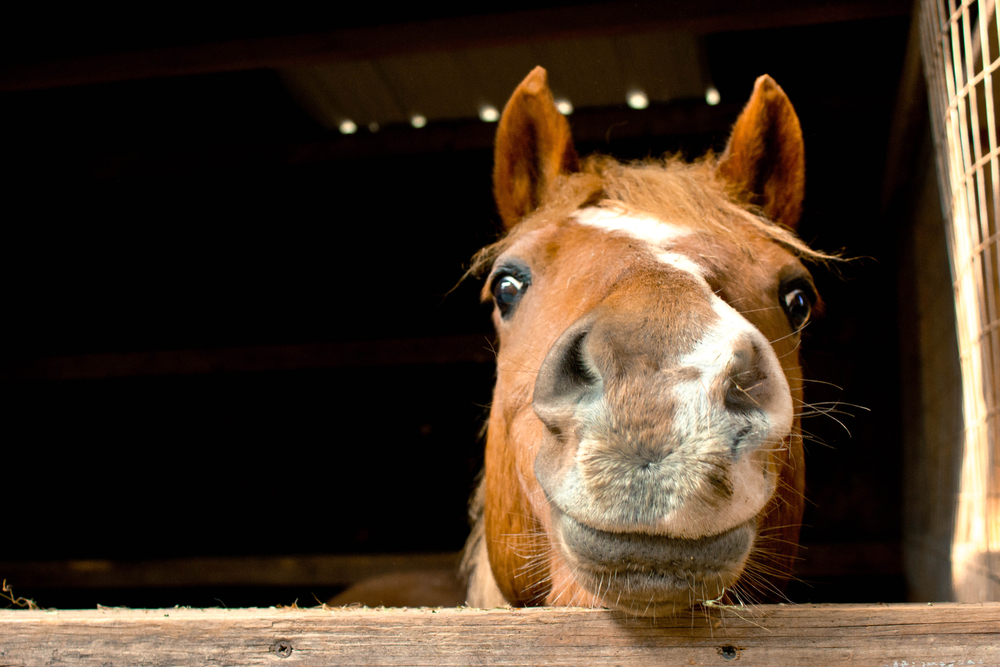Tuesdays with Tony
As a horse person, you are probably familiar with your horse’s guttural pouches, although you may not be familiar with what they are and the issues they can cause for your horse. For those of you who don’t know, let’s first discuss exactly what it is. Bear with me; as the most superior species, cats do not have guttural pouches, so I had to do a bit of research to determine what this structure is all about.
As I’ve always suspected, horses are indeed just full of hot air, as can be explained via their guttural pouches, which are, in fact, sacs of air. They’re on either side of the head just below their ears, and are an expansion of the eustachian tube which is the structure that prevents air and fluid from building up within the ear. A horse’s guttural pouch can hold up to an entire mug of coffee per pouch!
Within the pouches are some very vital structures including veins, arteries and nerves, covered by just a thin membrane. As you can imagine, when there is a problem with the guttural pouches those vital structures are at an increased risk for damage. Damage to these structures can lead to difficulty swallowing, breathing, facial expression and head posture problems. The most familiar problem is Strangles. However, there are other issues that can affect the guttural pouches, including guttural pouch mycosis, guttural pouch tympany, and temporohyoid osteoarthropathy. I know, it’s a mouthful, even for me.
Guttural Pouch Empyema
When I hear the word empyema, my mind immediately goes to food, and I think of empanadas. While empyema seems like a pretty fun word to say, and we all know I really love thinking about food, what it stands for is not fun or delicious. Empyema is the fancy doctor-word for a pocket of pus. Most commonly, empyema of the guttural pouches is caused by a bacterial infection. One such bacterial infection that can affect the guttural pouches is streptococcus equi equi, otherwise known as Strangles. The pus caused by the bacteria forms in guttural pouch and can drain through the eustachian tube into nasal passages and nostrils. Accompanying thick, mucoid nasal discharge are clinical signs including fever, depression and swelling under the jaw.
However, unlike other guttural pouch diseases, guttural pouch empyema does not usually affect the vital structures. As the name Strangles implies, the swelling under the horse’s jaw can become so enlarged and painful that the horse can have difficulty breathing to the point of respiratory distress. Rarely, the pus that forms in the guttural pouches fails to drain and can precipitate into hard balls called chondroids. As with all other balls associated with animals, these balls must be removed surgically. If they go undetected, horses can be silent shedders of the bacteria and spread Strangles without their owners knowing it.
Treatment for Strangles is supportive and includes anti-inflammatories, antibiotics and, rarely, surgical drainage of the guttural pouches. Strangles is one of the biggest reasons to never share water buckets, troughs, feed buckets, etc with horses you do not know.

Guttural Pouch Mycosis
Man, fungus really does like to cause problems for horses, from eyes to wounds to their guttural pouches. No matter the form, fungus is one of the most difficult and potentially deadly organisms that horses are up against. When a horse’s guttural pouch(es) becomes infected with a fungal organism, it attaches itself to the top of the guttural pouch, going undetected. Once attached there, it eats its way through the thin lining and attacks the nerves and arteries. Since the fungi go undetected and do not fill the guttural pouch like empyema does, clinical symptoms occur very rapidly and can be dramatic.
One of the most common symptoms of guttural pouch mycosis is bleeding from the nostrils. It can range from a trickle to profuse bleeding, which can quickly result in the horse’s death. If the fungal organism affects the nerves in the guttural pouches, mild to severe symptoms may occur. Mild symptoms typically resolve, however, severe symptoms can lead to respiratory distress, trouble swallowing, and other life-threatening problems that are nearly impossible to recover from. And I thought diabetes was a pain to deal with!
Guttural Pouch Tympany
As if horses were not already poorly designed, they can also develop a congenital problem associated with their guttural pouches called guttural pouch tympany. This affects foals very shortly after birth. Their guttural pouches fill with air that’s unable to escape. Oftentimes they can look like adorable little chipmunks (well, BIG little chipmunks). Usually, guttural pouch tympany does not cause major issues, but it can occasionally lead to difficulty swallowing and breathing. The only way to correct this problem is with surgical intervention. Of course, it can never be an easy fix with horses. They always have to make things as difficult as they can.
Temporohyoid Osteoarthropathy
Ear infections are the actual worst thing ever. I know, because I have them all the time. One thing horses do right: they do not usually get ear infections. Yes, I said usually. As we all know, there are always those 1 or 2 horses out there that like to break the rules. On the rare occasion that a horse develops an ear infection, it may end up affecting the middle ear. As we have already discussed, the ear and the guttural pouches are interlinked therefore, a middle ear infection can affect structure close to the guttural pouches.
The stylohyoid bone forms a joint called the temporohyoid joint, which can be visualized along the roof of the guttural pouch. If the middle ear infection progresses, it can lead to infection of the temporohyoid joint and stylohyoid bone. Once infected, the joint and bone become thickened and brittle and can eventually fracture with movement. As the fractures heal, boney changes occur, callus of the bones form, and arthritis can develop. Callus formation and enlargement of the joint and bone can impinge on the nerves within the area. The most commonly affected nerve is the facial nerve, which affects facial expression.
If the facial nerve becomes damaged, it can lead to a droopy ear, droopy eyelid, and/or droopy muzzle on the affected side. More severe damage can even result in a head tilt and incoordination. Antibiotics are the go-to choice of treatment for a mild infection. More severe infections result in removal of a portion of the stylohyoid bone which allows the tongue to continue to function normally but alleviates the pressure on the facial nerve. Without intervention, it is possible that damage to the facial nerve may not fully resolve, and the symptoms associated with facial nerve paralysis may persist even after treatment.
As can be seen, problems with guttural pouches are far more than Strangles, and require quick recognition by the owner and swift treatment by your veterinarian. There are other diseases and problems that can be associated with the guttural pouches beyond what I have discussed, however, they are rare. If you think your horse may be having an issue that is associated with their guttural pouch(es) please contact your veterinarian as soon as possible.
Until next week, stay warm and pet the cat!
~Tony
P.S. There is a Meet Tony event coming up! Well, the humans are calling it Open House here at the Clinic on November 20th, but it’s mostly about me. Mark your calendar, and come hang out with me from 10am to 1pm. There will be raffles prizes, drawings, and I’m even giving away a free Wellness Plan! I mean, what more could it take for you to come scratch my ears and give me a treat?
Tuesdays with Tony is the official blog of Tony the Clinic Cat at Springhill Equine Veterinary Clinic in Newberry, Florida. If you liked this blog, please subscribe below, and share it with your friends on social media! For more information, please call us at (352) 472-1620, visit our website at SpringhillEquine.com, or follow us on Facebook!
[jetpack_subscription_form title="Subscribe to Whinny's Wisdoms"]

